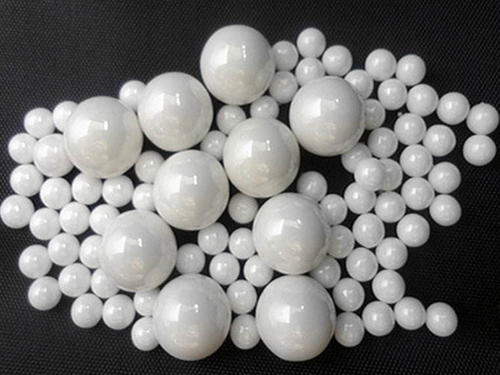

- 2020-11-23 09:36-
Ceramic material is an inorganic non-metallic material made of natural or synthetic compounds after forming and high-temperature sintering. It is one of the most important inorganic non-metallic materials that people pay attention to after non-metallic materials. It has the common advantages of both metal materials and polymer materials. In the process of continuous modification, its fragility has been greatly improved. Ceramic materials are unique in the field of materials with their excellent properties, are highly valued by people, and will play a very important role in the future social development.
Ceramic materials are divided into ordinary ceramic materials, nano ceramics and special ceramic materials. Oxide ceramics and nitride ceramics are both special ceramics.

Oxide ceramics
Oxide ceramics are ceramics made of one or several oxides. According to the components, it can be divided into single oxide ceramics, such as aluminum oxide, beryllium oxide, and titanium dioxide ceramics. Composite oxide ceramics, such as spinel, mullite, etc.
Oxide ceramics generally have a higher melting temperature and are very stable in an oxidizing atmosphere. It has high mechanical strength, electrical insulation properties and chemical stability. Except for beryllium oxide ceramics, its thermal conductivity is low. Usually use ultra-fine powder ingredients and add a small amount of sintering accelerators and modified additives.
According to the shape and performance requirements of the product, the oxide ceramics can be formed by various molding methods such as hot die casting, dry pressing, isostatic pressing, casting, extrusion, and grouting. Most products are fired in an oxidizing atmosphere, and sometimes vacuum, hydrogen or controlled atmosphere sintering is also used. The preparation process includes the steps of pre-sintering, formula, grinding, forming and sintering.
Among ceramic materials, alumina ceramics is one of the most widely used materials. Alumina ceramics have a series of excellent properties such as high mechanical strength, large insulation resistance, high hardness, wear resistance, corrosion resistance and high temperature resistance. It is widely used in various industries such as ceramics, textiles, petroleum, chemical, construction and electronics. Among the oxide ceramics, it is the most widely used new ceramic material with the largest production and sales volume.
Nitride ceramics
Nitride ceramics are ceramics whose main components are refractory compounds in which nitrogen and metal or non-metal elements are covalently bonded.
The widely used ceramics include silicon nitride, boron nitride, aluminum nitride and other ceramics. Among them, silicon nitride ceramic has the best anti-oxidation ability. It starts to oxidize at 1400°C and has good chemical resistance. Some also have special mechanical, dielectric or thermal properties. Compared with oxides, nitrides have poor oxidation resistance, which limits their applications in air.
The sintering of nitride ceramics is difficult. Therefore, its production cost is higher than that of oxide ceramics. During production, high-quality powder raw materials must be produced first, and then ceramic products are made by nitriding reaction sintering method, hot pressing sintering method, and hot isostatic pressing sintering method.
Nitride ceramics have extremely good chemical corrosion resistance and are good materials for the manufacture of various corrosion-prone parts. It can withstand almost all inorganic acids (except hydrofluoric acid) and caustic soda solutions below 30%, as well as corrosion by many organic substances. So it can be used to manufacture crucibles, ball valves, high temperature sealing valves, seals for various water pumps, etc.
Nitride ceramics is also a good electrical insulating material, and its electrical insulating properties can be compared with alumina ceramics. It also has microwave permeability and can be used as a radome. Its dielectric properties change very little with temperature, and it can be used up to at least 550°C at high temperatures. Its thermal shock resistance is superior in all kinds of ceramics, which makes it can be used at six Mach (that is, six times the speed of sound) or even at a flying speed of seven Mach. It is used to make rocket nozzles and Suitable material for turbine blades.
The Si3N4 structural ceramic material has many excellent properties, but its fatal weakness is its brittleness. It does not have the ability of plastic deformation like metal, and has a slippery dislocation system. When the applied energy exceeds a certain limit, it can only form a new surface to consume the applied energy, that is, a new crack surface is formed in the ceramic body. Cause catastrophic damage. Therefore, improving and enhancing the toughness of ceramic materials has become a topic of common concern for researchers. At present, the toughening methods of Si3N4 structural ceramics mainly include particle toughening, whisker or fiber toughening, ZrO2 phase transformation toughening, and self-toughening of columnar Si3N4 grains. In addition, the relatively high production cost of Si3N4 ceramics makes it difficult to promote and use them quickly. The low-cost production methods of Si3N4 ceramics should be actively studied to accelerate its industrialization process.
Previous:Previous:The Crystal Structure, Properties of Zirconia and Its Role in Refractory Materials Next: Next:Calculation Method of Zirconium Beads in Grinding Media